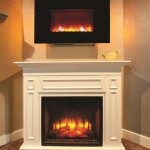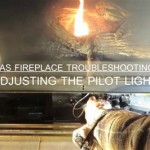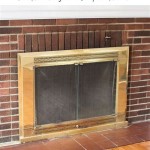Why Is There A Vent In My Fireplace Chimney Pipe?
The presence of a vent, often observed as a small opening or series of holes, in a fireplace chimney pipe is a feature that raises questions for many homeowners. Understanding the purpose and function of this vent is crucial for ensuring the safe and efficient operation of the fireplace and chimney system. This article will explore the reasons behind the existence of these vents, their different types, and their significance in the overall design and performance of the chimney.
Chimney systems are designed to safely expel the byproducts of combustion, primarily smoke and gases, from a fireplace or other heating appliance. A properly functioning chimney relies on the principles of draft, which is the movement of air and gases upwards through the chimney flue. This draft is influenced by several factors, including temperature differences between the inside and outside of the chimney, the height and diameter of the chimney, and the overall design of the system. The presence of a vent in the chimney pipe plays a role in managing these factors and optimizing the draft.
Dilution of Flue Gases
One of the primary reasons for incorporating a vent in a chimney pipe is to dilute the flue gases. Flue gases, which are the products of combustion, contain various compounds, including carbon monoxide, water vapor, and other potentially harmful substances. These gases are often hot and concentrated when they initially exit the heating appliance.
The vent allows ambient air to enter the chimney system, mixing with the flue gases. This dilution process lowers the concentration of harmful substances and reduces the overall temperature of the gases. By diluting the flue gases, the vent helps to prevent the formation of condensation within the chimney. Condensation can occur when hot, moist flue gases cool down as they travel up the chimney, causing water vapor to condense on the interior walls. This condensation can lead to the formation of creosote, a flammable substance that can increase the risk of chimney fires.
Furthermore, diluted flue gases are less corrosive. Undiluted flue gases can contain acidic compounds that can gradually corrode the metal or masonry of the chimney, leading to structural damage and eventual failure. By reducing the concentration of these corrosive elements, the vent helps to prolong the lifespan of the chimney.
The amount of air that enters through the vent is carefully calibrated to balance the need for dilution with the need to maintain adequate draft. Too much air can cool the flue gases excessively, reducing the draft and potentially causing backdrafting, where gases flow back into the living space. Therefore, the size and placement of the vent are important design considerations.
Draft Control and Stabilization
Another crucial function of a vent in a chimney pipe is draft control and stabilization. Draft, as previously mentioned, is the driving force behind the proper functioning of a chimney. However, draft can be affected by a variety of factors, including wind conditions, temperature fluctuations, and the tightness of the building's envelope.
Strong winds can create excessive draft, which can lead to rapid burning of fuel and inefficient heat output. Conversely, stagnant air or downdrafts can reduce or even reverse the draft, causing smoke and gases to enter the living space. The vent acts as a buffer, helping to stabilize the draft and minimize the effects of external factors.
Specifically, some vents are designed as barometric dampers. These devices automatically adjust the amount of air entering the chimney based on changes in atmospheric pressure and draft conditions. A barometric damper typically consists of a hinged plate that opens and closes in response to pressure differences. When the draft is too strong, the plate opens further, allowing more air to enter the chimney and reduce the draft. When the draft is weak, the plate closes, minimizing air intake and maintaining a stronger draft.
By stabilizing the draft, the vent helps to ensure consistent and efficient combustion. This can lead to better fuel economy, reduced emissions, and a more comfortable indoor environment. It also reduces the risk of dangerous conditions such as carbon monoxide poisoning, which can occur when the chimney is not drafting properly.
The specific design of the draft control vent can vary depending on the type of heating appliance and the characteristics of the chimney system. Some vents are designed for specific types of fuels, such as natural gas or wood, and are optimized for the combustion characteristics of those fuels.
Combustion Air Supply
In some instances, vents in chimney pipes also contribute to the combustion air supply. Combustion requires a sufficient amount of oxygen to burn fuel efficiently. In older homes, natural air infiltration often provided enough oxygen for combustion. However, modern homes are often tightly sealed to improve energy efficiency, reducing the amount of air that can naturally enter the building.
If the heating appliance does not receive enough combustion air, it can lead to incomplete combustion, which produces more carbon monoxide and reduces the efficiency of the appliance. In these cases, the vent in the chimney pipe can act as a supplemental source of combustion air.
The vent allows air from the surrounding area to enter the chimney system, where it can be drawn into the heating appliance. This helps to ensure that the appliance receives enough oxygen for complete combustion, even in tightly sealed homes. The use of a vent for combustion air supply is particularly common in appliances that are designed for sealed combustion, where air is drawn directly from outside the building.
It is important to note that the use of a vent for combustion air supply must be carefully considered and properly installed. If the vent is not properly sized or located, it can interfere with the draft and potentially lead to problems. It is also essential to ensure that the vent is not blocked by debris or other obstructions.
The location of the vent is a critical factor in its effectiveness as a combustion air supply. Typically, the vent is located near the base of the chimney, where it can draw air from the surrounding area. However, the precise location may vary depending on the design of the appliance and the characteristics of the building.
In conclusion, the vent in a fireplace chimney pipe serves multiple important functions, including dilution of flue gases, draft control and stabilization, and, in some cases, combustion air supply. Understanding these functions is essential for ensuring the safe and efficient operation of the fireplace and chimney system. Proper maintenance and inspection of the vent are crucial for preventing problems and prolonging the lifespan of the chimney.

Fireplace Vent Types Explained Magic Touch Mechanical
Gas Fireplace Venting Explained Heat Glo

What Are The Best Ways To Vent A Gas Fireplace Zoroast

What Is A Chimney Flue The Mad Hatter

What Are The Best Ways To Vent A Gas Fireplace Zoroast

Say Goodbye To Chimney Downdrafts Our Expert Guide

What Is Chimney Venting Why Do We Need It Vertical Care

Rock Vent Class A Wall Pass Through Installation Overview

Fireplaces And Wood Stoves Have Proper Ventilation Building America Solution Center

Fireplace Cover To Keep Cold Air Out
Related Posts








